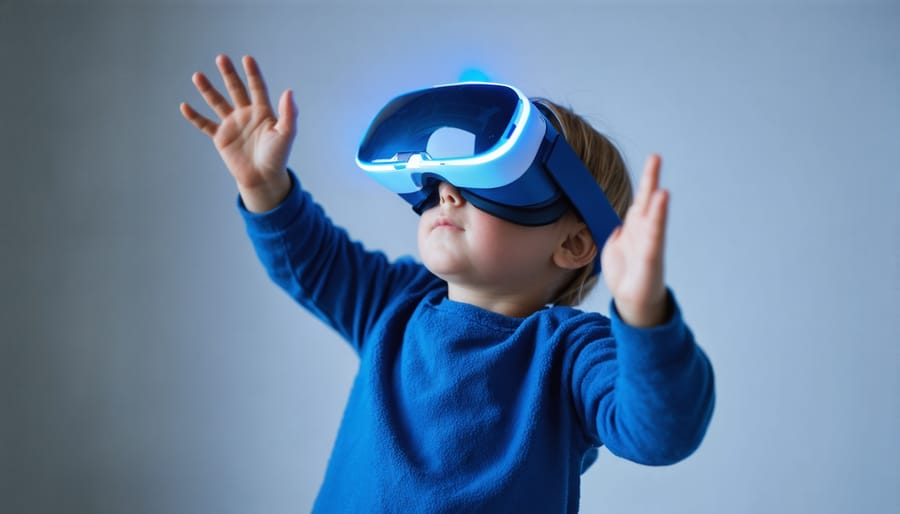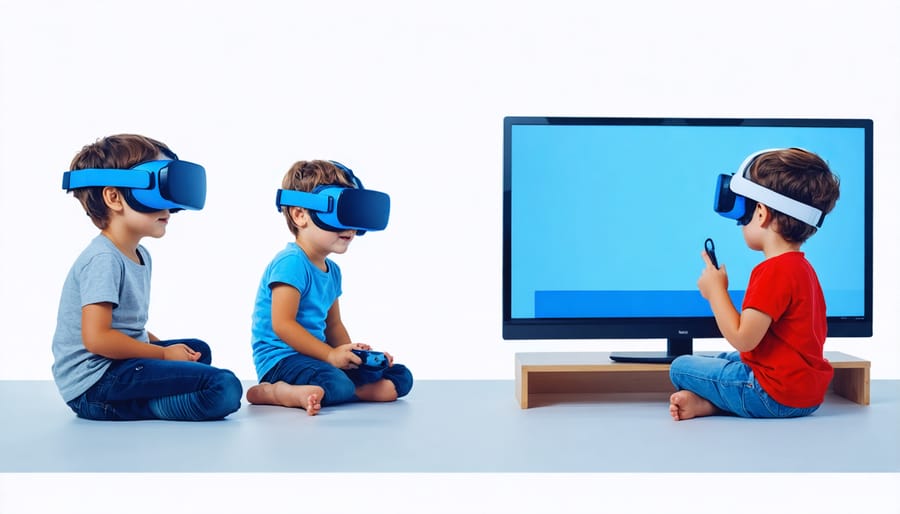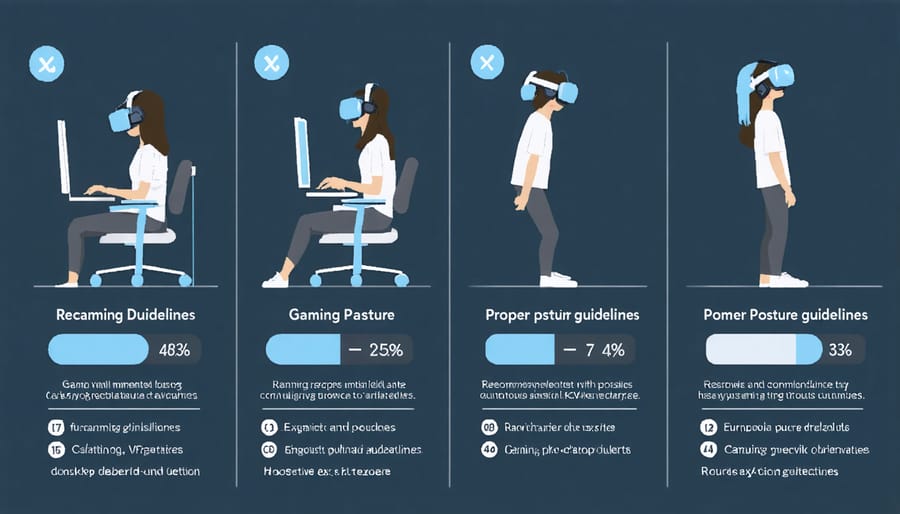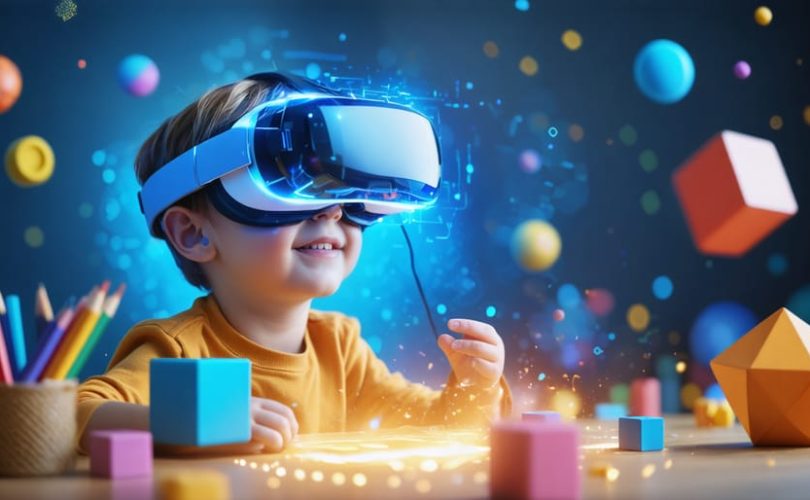Virtual reality gaming opens up extraordinary possibilities for learning, connection, and creative expression – transforming how our children play and develop in the digital age. As VR technology becomes more accessible and refined, parents increasingly recognize its potential to enhance problem-solving skills, spatial awareness, and social interaction when used thoughtfully. Research shows that interactive VR experiences can improve focus, hand-eye coordination, and emotional intelligence in children aged 7-15, while providing engaging ways to explore subjects from science to art in immersive 3D environments.
Yet many parents understandably question how to balance these benefits with screen time concerns and physical safety. The key lies in understanding age-appropriate content, setting healthy usage boundaries, and selecting educational games that align with your child’s developmental stage. When implemented mindfully alongside traditional play and learning, VR gaming can become a powerful tool for growth – one that prepares children for an increasingly digital future while protecting their wellbeing in the present.
How VR Games Support Your Child’s Development
Physical Activity and Coordination
Interactive VR games are revolutionizing the way children engage in physical activity, offering exciting opportunities for motor skills development through immersive play. When children reach out to catch virtual butterflies, duck beneath obstacles, or dance to rhythm games, they’re not just having fun – they’re developing crucial physical coordination skills.
Many VR games encourage full-body movement, requiring players to stretch, bend, and maintain balance. Popular titles like Beat Saber and Just Dance VR get kids moving naturally while they’re absorbed in the gaming experience. These activities can be especially beneficial for children who might be hesitant about traditional sports or physical education classes.
Parents have reported seeing improvements in their children’s hand-eye coordination, spatial awareness, and overall physical confidence after regular VR gaming sessions. However, it’s important to ensure proper supervision and take regular breaks to prevent fatigue and maintain safe play practices.

Social Skills and Collaboration
Virtual reality games are revolutionizing the way children interact and develop social skills in a digital environment. Through multiplayer VR experiences, children can connect with peers worldwide, fostering meaningful friendships and learning essential collaboration skills in a safe, controlled setting.
Many VR platforms offer supervised social spaces where children can practice real-world social interactions without the anxiety that sometimes accompanies face-to-face encounters. Games like “RecRoom” and “VRChat Kids” provide moderated environments where young players can work together on team challenges, solving puzzles, or creating virtual art projects.
Dr. Sarah Chen, a child development specialist, notes: “Multiplayer VR games can help children develop empathy, communication skills, and teamwork abilities. When children collaborate in virtual environments, they learn to respect different perspectives and work towards common goals.”
Parents have reported positive changes in their children’s social confidence after regular participation in structured VR social activities. These experiences can be particularly beneficial for children who struggle with traditional social settings, providing them with a stepping stone to develop real-world relationships.

Safe and Healthy VR Gaming Practices
Age-Appropriate Content Selection
Selecting age-appropriate VR games is crucial for ensuring children have a positive and safe virtual reality experience. For young children ages 7-9, focus on educational games that teach basic concepts through interactive storytelling and simple problem-solving activities. Games like “Job Simulator” and “Vacation Simulator” offer playful learning experiences without overwhelming complexity.
Tweens (10-12) can handle more challenging content, including puzzle games and creative platforms like “Tilt Brush” or “Fantastic Contraption.” These games encourage spatial thinking and creative expression while maintaining appropriate content levels.
For teenagers (13+), more complex narrative games and social VR experiences become suitable, though parents should still monitor content ratings. Games like “Beat Saber” and “Rec Room” offer engaging experiences while promoting physical activity and social interaction.
When selecting games, consider these key factors:
– Age ratings from ESRB or PEGI
– Duration of recommended play sessions
– Physical movement requirements
– Social interaction features
– Content themes and intensity levels
Remember to start with shorter play sessions and gradually increase duration as children become more comfortable with VR technology. Always supervise initial sessions and regularly check in about their comfort level and experience.
Screen Time and Physical Comfort
While virtual reality games can be incredibly engaging, it’s essential to establish healthy screen time limits and maintain physical comfort during play. Start with 15-20 minute sessions for children and gradually increase based on comfort level. Watch for signs of eye strain or dizziness, which might indicate it’s time for a break.
Create a comfortable play space by ensuring proper ventilation and room temperature. The VR headset should fit snugly but not too tight, and taking short breaks every 30 minutes helps prevent fatigue. Consider using a timer or built-in break reminders available in many VR systems.
Dr. Sarah Chen, a pediatric optometrist, recommends the “20-20-20 rule”: every 20 minutes, look at something 20 feet away for 20 seconds. This helps reduce eye strain and maintains visual comfort. Remember to stay hydrated and encourage stretching exercises between gaming sessions.
For younger players, adult supervision during VR sessions ensures they’re following safety guidelines and maintaining proper posture. Making comfort and safety a priority helps create a positive VR gaming experience for everyone.

Recommended VR Games for Different Age Groups
Ages 7-9: Foundation Building Games
During ages 7-9, children are naturally curious and eager to learn, making this the perfect time to introduce foundational VR games that combine education with entertainment. Games like “Color Space VR” allow children to explore their artistic side by painting in three dimensions, helping develop spatial awareness and creative expression in a safe, enchanting environment.
“Discovery Expeditions” takes young learners on virtual field trips to historical sites and natural wonders, making learning immersive and memorable. These educational adventures help children retain information better while fostering a genuine interest in subjects like history and science.
For building problem-solving skills, “Puzzle Palace VR” offers age-appropriate challenges that gradually increase in complexity. Children learn patience, strategic thinking, and persistence while having fun in a colorful, encouraging environment.
“Music Maker VR” introduces basic musical concepts through interactive play, allowing children to experiment with different instruments and compose simple melodies. This helps develop rhythm, coordination, and creative expression.
When selecting games for this age group, look for those featuring:
– Clear, simple instructions
– Positive reinforcement
– Short play sessions (15-20 minutes)
– Non-competitive options
– Parental control settings
– Educational elements woven into gameplay
Remember to maintain regular breaks and encourage discussion about their virtual experiences, helping children process and connect their learning to the real world.
Ages 10-12: Advanced Interactive Experiences
At ages 10-12, children are ready for more sophisticated virtual reality experiences that challenge their cognitive abilities and foster collaboration. Games like “Mission: ISS” let kids explore the International Space Station while learning about space science and problem-solving in zero gravity. The popular “Keep Talking and Nobody Explodes” encourages essential communication skills as players work together to defuse virtual bombs through clear instructions and teamwork.
Educational games like “Titans of Space PLUS” take learning to new heights, allowing children to explore the solar system in stunning detail while absorbing complex astronomical concepts. These experiences combine entertainment with educational value, making learning both engaging and memorable.
For creative development, “Tilt Brush” and “SculptrVR” enable kids to create three-dimensional artworks and structures, promoting spatial awareness and artistic expression. These tools help children understand complex geometric concepts while exercising their imagination.
Many of these games also include multiplayer options, allowing children to collaborate with peers in safe, monitored environments. “Rec Room” offers various mini-games and creative spaces where kids can interact with others while practicing social skills and digital citizenship.
Parents should maintain active involvement, discussing game experiences and ensuring appropriate content selection. Setting reasonable time limits and encouraging breaks helps maintain a healthy balance between virtual and real-world activities. Regular check-ins about comfort levels and any motion sickness symptoms are also important for this age group.
Interactive virtual reality gaming offers an exciting new frontier in entertainment and development, but like all good things, balance is key. As we’ve explored throughout this article, VR games can provide remarkable benefits for children’s creativity, physical activity, and social skills when used appropriately. However, it’s essential to establish healthy boundaries and maintain open communication about gaming habits.
Remember to start with age-appropriate games, set reasonable time limits, and ensure proper safety measures are in place. Create a supportive environment where your child can enjoy the immersive benefits of VR while maintaining a healthy balance with other activities, including outdoor play, face-to-face social interactions, and traditional learning experiences.
As technology continues to evolve, stay informed about the latest research and recommendations. Work with your child to develop responsible gaming habits that will serve them well into the future. By taking a thoughtful, balanced approach to VR gaming, you can help your child harness the positive potential of this technology while safeguarding their overall well-being and development. The future of virtual reality gaming is bright – let’s help our children experience it safely and meaningfully.

